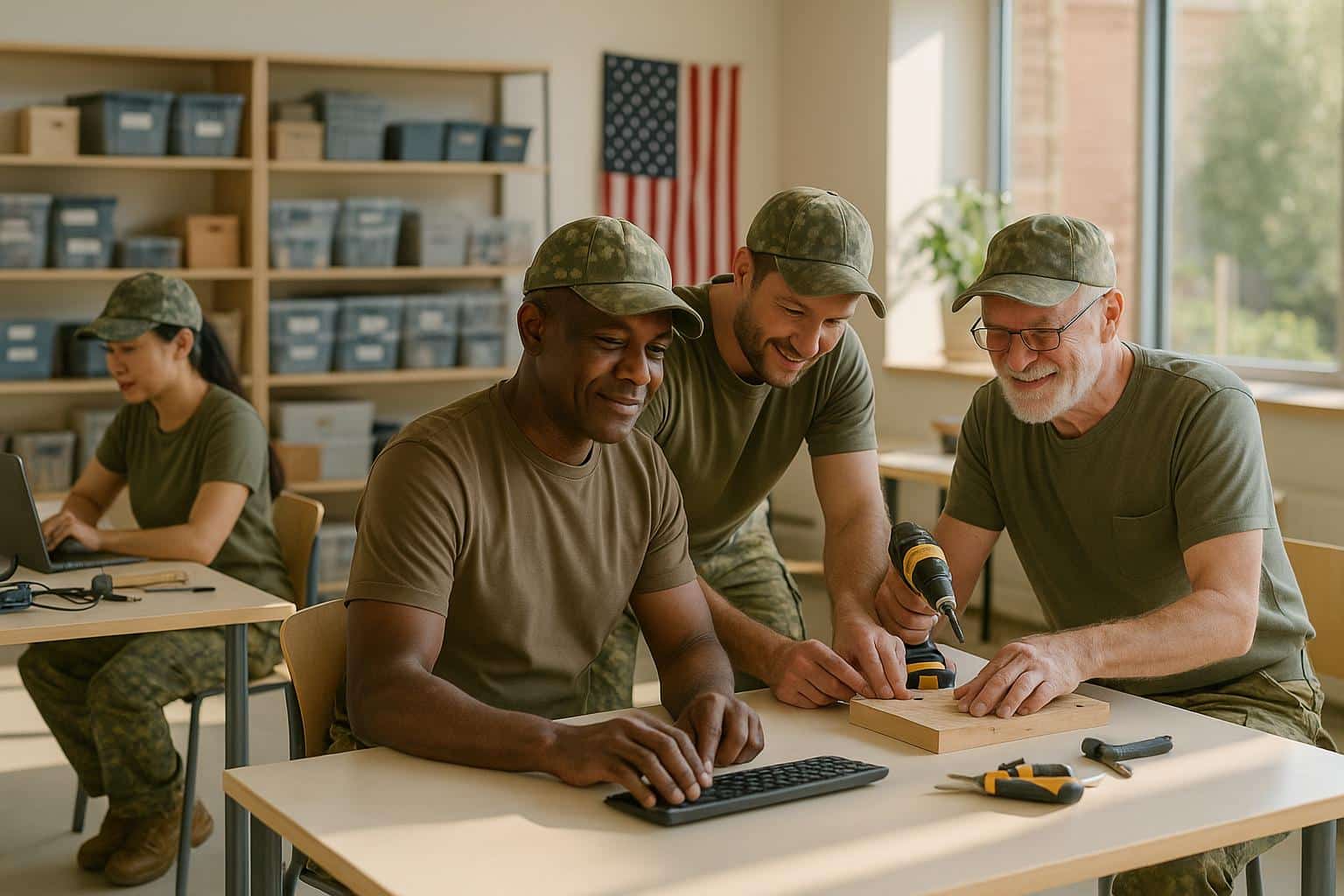Veterans transitioning to civilian life often face challenges like unemployment and homelessness. Job training programs provide them with skills, stability, and a sense of purpose. You can help by donating money, time, or items. Financial contributions fund training resources, volunteering allows you to mentor or teach, and donating professional clothing or tools supports their journey. Local initiatives like City Thrift turn your contributions into direct support for veterans in need. Choose how you want to make an impact today.
What Homeless Veterans Need
Homeless veterans often face unique hurdles when trying to reenter the civilian workforce. While their military service equips them with strong technical abilities, these skills don’t always align with what civilian employers are looking for. Vocational training programs step in to bridge this gap, offering specialized training and career guidance to help veterans build the skills they need to thrive in the job market. Let’s explore the challenges veterans face, the types of training available, and how these programs can make a real difference.
Challenges Homeless Veterans Encounter
One of the biggest challenges for veterans is translating their military experience into terms that civilian employers understand. This disconnect can make it harder for them to land stable jobs, prolonging their struggle to achieve financial security.
Types of Job Training Programs Available
Vocational training programs focus on teaching practical, job-specific skills tailored to civilian industries. These programs often cover trades, like construction or plumbing, as well as fields in emerging technologies such as IT or renewable energy. By aligning with civilian workforce demands, these programs help veterans adapt their military expertise to roles that are in demand.
The Impact of Job Training on Veterans
Job training doesn’t just equip veterans with technical skills – it also builds their confidence and opens doors to stable employment and long-term career growth. With the right training, veterans can turn their military experience into a foundation for a successful future in the civilian workforce.
3 Ways to Donate: Money, Time, and Items
Helping veterans transition to civilian careers through job training programs doesn’t require a huge commitment. Whether you can give $10 or 10 hours, your support can have a meaningful impact. Here are three practical ways you can contribute.
Donating Money
Financial contributions are a direct way to fuel job training programs for veterans. These donations cover costs like training materials, instructor salaries, and hands-on equipment, ensuring veterans have access to the resources they need to succeed.
For example, the Purple Heart Foundation has raised over $250 million to fund job training and counseling for veterans. Similarly, the Gary Sinise Foundation prides itself on efficiency, with 89 cents of every dollar donated going directly to programs that support service members, veterans, first responders, and their families.
Some funds, like the Purple Heart Foundation’s Veterans Critical Assistance Grant Fund, focus on providing immediate financial relief to veterans in need. Whether you make a one-time gift or set up recurring donations, even a monthly $25 contribution can provide consistent support for these programs.
Donating Your Time
Volunteering your time and expertise is another powerful way to support veterans. If you have professional skills, you can help teach vocational trades or guide veterans through the job transition process. Organizations like Veterans Transition Support and V-VET welcome volunteers to provide hands-on instruction.
Mentorship is another impactful option. Programs like Hire Heroes USA offer remote mentoring opportunities, allowing you to assist veterans with career planning, networking, and interview preparation. You could also help veterans translate their military experience into civilian job skills by serving as a resume writer or employment specialist. Hosting webinars to share industry-specific knowledge is another way to make a difference.
Donating Items for Training and Support
Physical donations can address specific needs and provide veterans with the tools to succeed. Items like work clothes – dress shirts, suits, or steel-toed boots – can be essential for veterans entering job training or starting a new career.
Other useful donations include tools, specialized equipment, computers, and even transportation assistance like gas cards or bus passes. Before donating, check with the organization to ensure your items meet their current needs and can be put to immediate use.
Next, learn how City Thrift turns your contributions into meaningful support for veterans.
How to Donate Through City Thrift
City Thrift plays a vital role in supporting veteran job training while uplifting the Kansas City community. By donating items or shopping at their stores, you’re directly contributing to programs designed to help homeless veterans and others in need achieve stability. This local approach ensures your support makes an immediate and meaningful impact.
How City Thrift Helps Veterans
City Thrift operates nonprofit thrift stores across Kansas City and nearby areas, with all proceeds benefiting City Union Mission. This organization is dedicated to assisting people experiencing homelessness – including veterans – by equipping them with tools and opportunities to regain stability and well-being.
Here’s how it works: items donated to City Thrift are sold in their stores, and the revenue directly funds City Union Mission’s programs. These programs provide homeless veterans with housing assistance, vocational training, and other critical services. What makes this model special is that every dollar stays within the local community, creating life-changing opportunities for those in need.
By maintaining a consistent inventory of donated goods, City Thrift generates a steady income stream to support initiatives like job training and career development. Your contributions – whether clothing, furniture, or household items – translate into real opportunities for veterans to gain marketable skills and secure stable employment.
What You Can Donate
City Thrift accepts a wide variety of donations, ensuring almost anything you no longer need can help make a difference.
- Clothing: Professional attire is especially valuable, helping veterans prepare for job interviews and workplace training.
- Furniture: Items like couches, tables, chairs, and bedroom sets are highly impactful, generating significant funds for job training programs.
- Household Items: Kitchenware, small appliances, books, and home décor are all welcome and help stock the stores.
- Toys and Children’s Items: These not only benefit families in the community but also contribute to funding veteran support programs.
Donating through City Thrift gives your unused items a second life while directly funding programs that help veterans build new careers and achieve long-term stability.
How to Get Involved with City Thrift
Your support doesn’t have to stop with donations. There are several ways to get involved:
- Donate Items: Drop off your contributions at any City Thrift location between 9:00 AM and 9:00 PM, making it easy to fit into your schedule.
- Volunteer: Offer your time to help in the stores by sorting donations, organizing merchandise, or assisting shoppers. City Thrift also provides volunteer opportunities through special programs that serve the community.
- Make a Financial Contribution: Direct monetary donations are another way to support City Union Mission’s efforts. Your financial gift goes straight to programs that provide job training and career development for homeless veterans.
Whether you’re donating items, volunteering your time, or contributing financially, your involvement makes a measurable difference. Every effort helps veterans in the Kansas City area rebuild their lives and achieve stability.
How to Make Your Donation Count
Donating is more than just a generous act – it’s an opportunity to bring about real, measurable change. To ensure your contribution truly makes a difference, it’s important to go beyond good intentions and take a closer look at the programs you’re supporting. Focus on organizations that prioritize meaningful outcomes over surface-level activity, and verify their metrics to see how your donation will drive genuine progress.
How to Check Organizations and Programs
Some organizations may boast impressive numbers – like how many veterans they’ve served or the amount of funds raised – but these figures don’t always tell the full story. What really matters is whether their efforts are leading to tangible improvements, like helping veterans secure employment or enhance their quality of life.
The most reliable organizations track and share clear outcome metrics rather than just input numbers. For example, they might measure success based on veterans’ employment rates or income growth after completing a program. Unfortunately, many veteran employment organizations still focus on basic activities without adopting standardized methods to evaluate their overall effectiveness.
Transparency is crucial when assessing an organization’s trustworthiness. A strong veteran employment program will openly share standardized reports on its results, clearly showing how it measures success and providing updates on veteran outcomes. When researching, you can ask questions like: How many veterans completed the program compared to those who started? What percentage found jobs within a specific timeframe? Organizations with well-structured programs will have this data readily available.
It’s also worth considering organizations that make a noticeable impact in your local community. For example, City Thrift-supported programs often deliver measurable local results. You might even have the chance to meet program graduates, tour training facilities, and see firsthand how your donation is helping veterans achieve success.
Once you’ve evaluated the effectiveness of a program, the next step is determining the donation method that works best for you.
Picking the Best Way to Donate
The way you choose to donate can depend on your resources, schedule, and personal interests. Each method offers unique benefits and opportunities to make a difference.
| Donation Method | Best For | Time Commitment | Impact Level |
|---|---|---|---|
| Money | Those seeking a quick and direct impact, like busy professionals or retirees | Minimal (one-time or recurring) | High – directly funds training programs and support services |
| Time/Volunteering | Individuals with flexible schedules or those seeking personal connection | 2–8 hours per week | Very High – offers hands-on mentorship and practical support |
| Items | Families or individuals looking to donate professional clothing or declutter | 1–2 hours for sorting and drop-off | Moderate – generates funding through resale to support veteran services |
Volunteering your time can leave a lasting impression – not just on the veterans you help, but on you as well. Many veterans benefit greatly from mentorship, resume reviews, and mock interviews. Your professional expertise can provide the guidance and confidence they need to navigate workplace challenges.
Donating items is another impactful way to contribute. When you give items like professional clothing, they can be resold to generate funds that sustain vital services for veterans over the long term.
For an even greater impact, consider combining these methods. By addressing immediate needs through monetary or item donations while also building meaningful relationships through volunteering, you can help empower veterans to achieve lasting success.
How You Can Help Veterans
Helping veterans access job training doesn’t have to be a big undertaking. By donating money, time, or even household items, you can make a direct impact on programs that provide essential services and training opportunities for homeless veterans. Your efforts play a role in both their immediate needs and their long-term stability.
There are many ways to get involved, and each offers its own advantages. Whether you contribute financially, volunteer your time, or donate items, you can find an approach that aligns with your resources and schedule.
Local initiatives can amplify your contributions even further. For example, organizations like City Thrift use community-driven efforts to make a lasting difference. When you donate items to City Thrift, the proceeds go directly to City Union Mission’s programs, which support homeless veterans. This means that your old clothing or household goods don’t just stop being useful – they become part of a larger effort to create sustainable funding for job training programs in the Kansas City area.
When deciding where to donate or volunteer, focus on organizations that value transparency and measurable results. Look for programs that openly share their impact and provide opportunities to see the difference you’re making, whether that’s through meeting program graduates, touring training facilities, or volunteering alongside veterans. These experiences not only build trust but also allow you to witness the real-life outcomes of your support.
FAQs
What skills do veterans gain from vocational training programs to help them succeed in civilian careers?
Vocational training programs provide veterans with a range of practical skills tailored to help them succeed in civilian careers. These often focus on areas like leadership, clear communication, problem-solving, flexibility, and time management. These abilities not only boost their competitiveness in the job market but also ease their adjustment to new professional settings.
By leveraging their military experience, these programs prepare veterans to thrive in various fields, including technology, healthcare, skilled trades, and management. Investing in these initiatives plays a key role in supporting their smooth transition to civilian life.
How can I make sure my donation to a veterans’ job training program truly helps those in need?
To make sure your donation has a meaningful impact, focus on organizations that clearly explain how they allocate funds. Look for detailed breakdowns showing what percentage goes toward job training and employment services for veterans. Trustworthy programs often highlight success stories or share measurable results, like how many veterans find jobs after completing their training.
It’s also a good idea to review independent assessments from watchdog groups like the BBB Wise Giving Alliance or CharityWatch. These organizations evaluate charities for accountability and efficiency, giving you confidence that your contribution is being put to good use in helping veterans achieve lasting success.
What are the best items to donate to help support veterans’ job training programs, and how do these donations make an impact?
Donating items like clothing, furniture, electronics, books, and household goods can have a real impact on veterans’ lives. These contributions are often sold through nonprofit thrift stores, with the proceeds going directly toward programs like vocational training, career counseling, and skill-building opportunities.
When you donate, you’re not just clearing out your home – you’re giving veterans the resources they need to transition into civilian careers, gain financial independence, and create a secure future. Each item you give helps those who have served our country take meaningful steps toward rebuilding their lives and thriving in the workforce.






